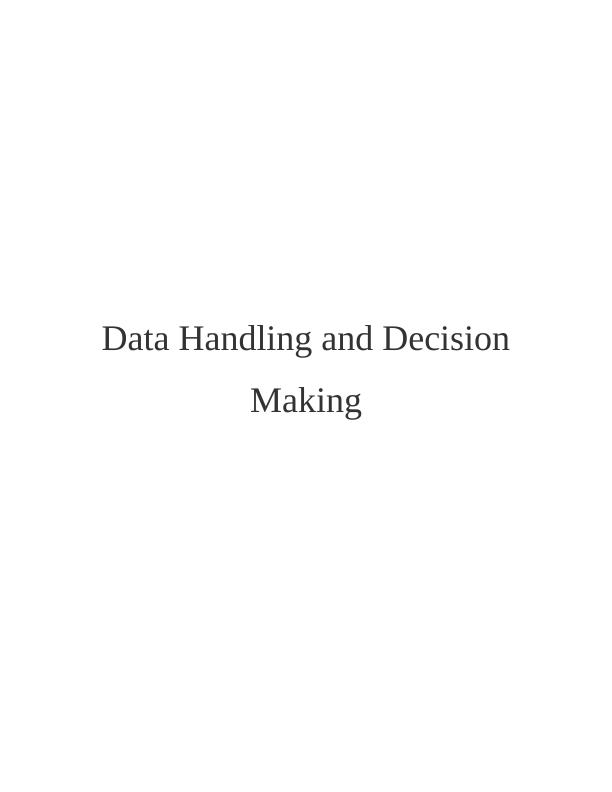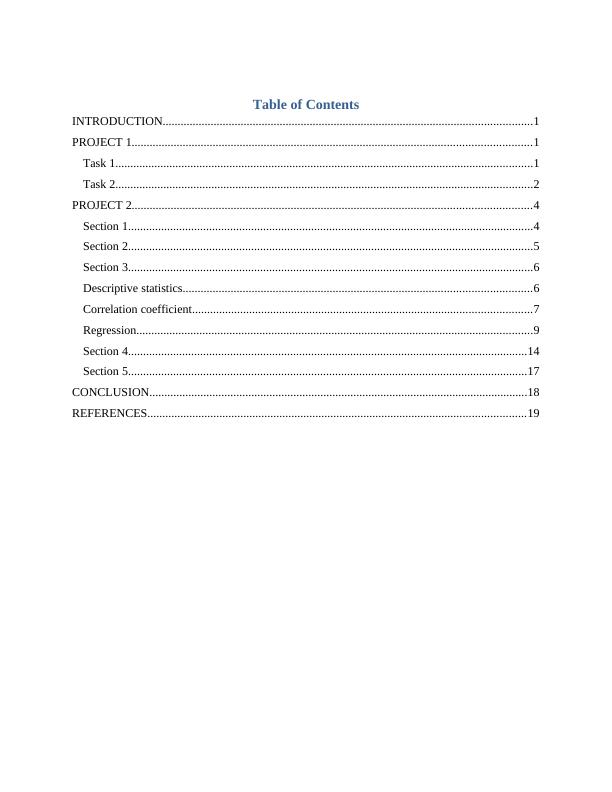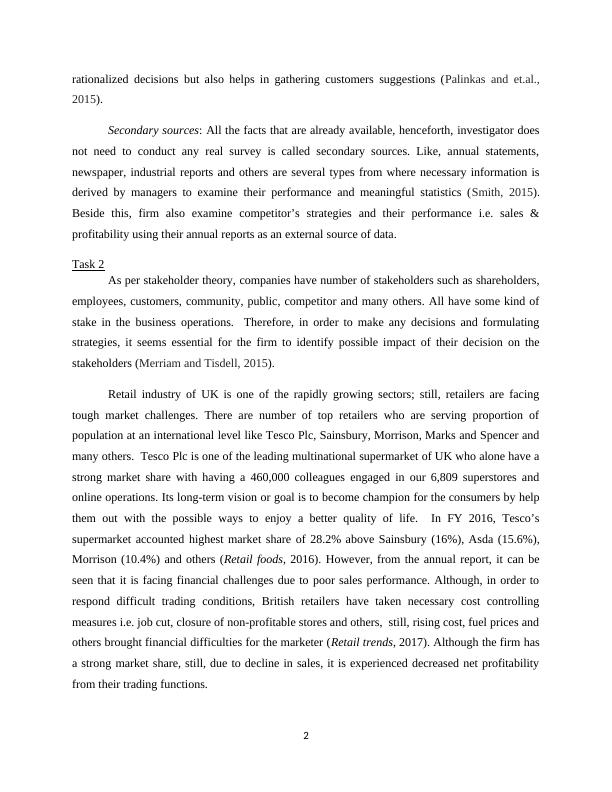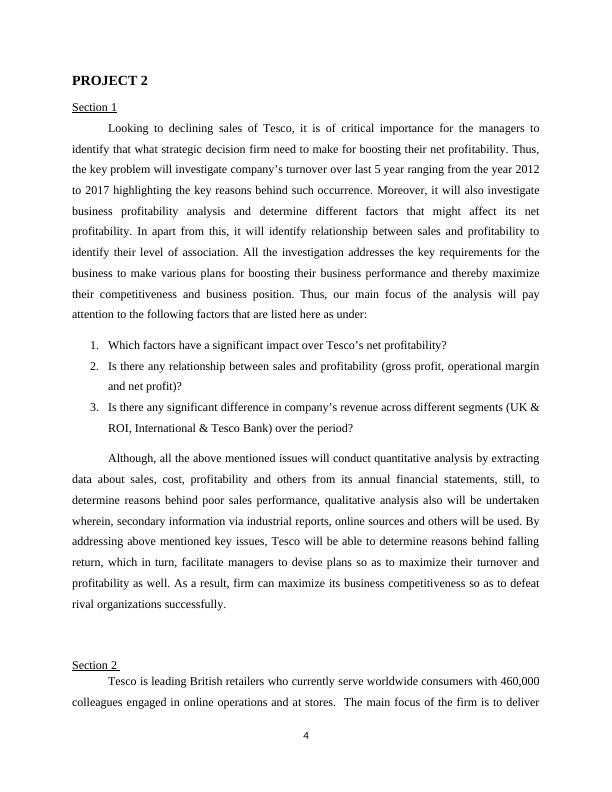Data Handling and Decision Making
Added on 2020-06-03
28 Pages6598 Words263 Views
Data Handling and DecisionMaking

Table of ContentsINTRODUCTION...........................................................................................................................1PROJECT 1.....................................................................................................................................1Task 1...........................................................................................................................................1Task 2...........................................................................................................................................2PROJECT 2.....................................................................................................................................4Section 1.......................................................................................................................................4Section 2.......................................................................................................................................5Section 3.......................................................................................................................................6Descriptive statistics....................................................................................................................6Correlation coefficient.................................................................................................................7Regression....................................................................................................................................9Section 4.....................................................................................................................................14Section 5.....................................................................................................................................17CONCLUSION..............................................................................................................................18REFERENCES..............................................................................................................................19

INTRODUCTION The procedure of organizational decisions flows through varied steps such as from information collection, comparative evaluation and selection of the most appropriate alternative which can fuel business growth. The purpose of this assessment is to explore various data gathering and analysis tools to devise rationalized business decisions. The report will presented both the primary as well as secondary data collection methods and its evaluation using different statistical tools and techniques. The first project deals with data utilization and its uses to facilitate decision making process. However, the second project is based on practical analysis so as to provide meaningful insight towards the findings for viable decisions. PROJECT 1Task 1For every business decision, entity requires collecting huge set of data that are necessaryto be gathered before reaching to any final decisions. There are various sources of data fromwhere necessary information can be extracted by the managers. Mainly, there are two set of datafrom where decision-makers generally collect required information that are primary andsecondary data set that are presented here as under: Primary source: Information that is originally collected by the researchers conducting areal market survey, observation, field analysis and questionnaire are known as primary sources(Best and Kahn, 2016). It tackles specific need of the investigator, for instance, in corporateworld, now-a-days, in order to understand customer preferences, taste, desire, firms and identifytheir satisfaction level, they often conduct consumer survey questionnaire as a source of primarydata. It aware business managers about consumer expectations, price sensitivity, their feedbackand various factors that influence their buying behavior. Using consumer feedback, companiescan identify gap in their services and consumer satisfaction and make suitable plans to satisfyusers need (Goodman, Cryder and Cheema, 2013). While collecting primary data set, it isnecessary to keep into account confidentiality and privacy aspect so as to mitigate any ethicalconcerns. Less response rate, misleading information and others are some issues that might befaced in acquiring primary information, still, it is of great use which not help businesses in1

rationalized decisions but also helps in gathering customers suggestions (Palinkas and et.al.,2015). Secondary sources: All the facts that are already available, henceforth, investigator doesnot need to conduct any real survey is called secondary sources. Like, annual statements,newspaper, industrial reports and others are several types from where necessary information isderived by managers to examine their performance and meaningful statistics (Smith, 2015).Beside this, firm also examine competitor’s strategies and their performance i.e. sales &profitability using their annual reports as an external source of data.Task 2As per stakeholder theory, companies have number of stakeholders such as shareholders,employees, customers, community, public, competitor and many others. All have some kind ofstake in the business operations. Therefore, in order to make any decisions and formulatingstrategies, it seems essential for the firm to identify possible impact of their decision on thestakeholders (Merriam and Tisdell, 2015). Retail industry of UK is one of the rapidly growing sectors; still, retailers are facingtough market challenges. There are number of top retailers who are serving proportion ofpopulation at an international level like Tesco Plc, Sainsbury, Morrison, Marks and Spencer andmany others. Tesco Plc is one of the leading multinational supermarket of UK who alone have astrong market share with having a 460,000 colleagues engaged in our 6,809 superstores andonline operations. Its long-term vision or goal is to become champion for the consumers by helpthem out with the possible ways to enjoy a better quality of life. In FY 2016, Tesco’ssupermarket accounted highest market share of 28.2% above Sainsbury (16%), Asda (15.6%),Morrison (10.4%) and others (Retail foods, 2016). However, from the annual report, it can beseen that it is facing financial challenges due to poor sales performance. Although, in order torespond difficult trading conditions, British retailers have taken necessary cost controllingmeasures i.e. job cut, closure of non-profitable stores and others, still, rising cost, fuel prices andothers brought financial difficulties for the marketer (Retail trends, 2017). Although the firm hasa strong market share, still, due to decline in sales, it is experienced decreased net profitabilityfrom their trading functions. 2

Thus, poor sales and profitability are the main problem faced by Tesco Plc, it directlyaffects investor’s decisions. It is because; investors only like to invest their valuable money inthe enterprise if it delivers an impressive return to them. However, due to declined in sales,Tesco’s profitability is adversely affected which directly influence shareholders to a great extent.Moreover, it also affects other stakeholders too, for instance, employee want good salarypackages, growth opportunities and other benefits, therefore, they desire to work in that companywhich is generating rising return on their total turnover. In despite of this, customer preferences,choices and taste directly affect business sales. Thus, as per the discussion, although sales affects various stakeholders, still, shareholdersare the most important among all who highly affected by Tesco’s net profitability. Moreover, itcan bring financial crunch for the company also. For instance, if due to less return, shareholderdecides to dispose off their equity in the market, then, company may face financial difficulties. Inorder to satisfy their capital need, they need to use external borrowing, which in turn, resultantexcessive interest burden (Witten and et.al., 2016). It can result in solvency issues and financialproblems as well. Similarly, managers have prime responsibility to make strategies to boost itsturnover and net profit, so that, firm can succeed successfully in the competitive arena. Ouranalysis will help company’s executive and mangers to make right policy, plans and decisionsabout to overcome issues of patchy sales growth and ineffective return. In order to examine poorsales and profit, necessary financial data will be extracted from the Tesco’s annual report. It is asecondary/internal source which provides authentic and accurate figures in its financialstatement. However, analysis will be undertaken using statistical package (SPSS), in which,descriptive as well as inferential statistics will be used for the analyzing various financial dataset.Ethical issues that might be face during data gathering includes breach of confidentialityaspect. Moreover, as data is decided to gather from the annual report of Tesco, therefore, it isnecessary to receive prior consent from the authority so as to acquire access. Besides this, dataownership is necessary to be acknowledged and it must be adequate, time-updated and relevantas well. For the given problem, company’s financial data for the last four years will be used andmaintained with full confidentiality and privacy to avoid any possibility of data breach. 3

PROJECT 2Section 1Looking to declining sales of Tesco, it is of critical importance for the managers toidentify that what strategic decision firm need to make for boosting their net profitability. Thus,the key problem will investigate company’s turnover over last 5 year ranging from the year 2012to 2017 highlighting the key reasons behind such occurrence. Moreover, it will also investigatebusiness profitability analysis and determine different factors that might affect its netprofitability. In apart from this, it will identify relationship between sales and profitability toidentify their level of association. All the investigation addresses the key requirements for thebusiness to make various plans for boosting their business performance and thereby maximizetheir competitiveness and business position. Thus, our main focus of the analysis will payattention to the following factors that are listed here as under: 1.Which factors have a significant impact over Tesco’s net profitability? 2.Is there any relationship between sales and profitability (gross profit, operational marginand net profit)? 3.Is there any significant difference in company’s revenue across different segments (UK &ROI, International & Tesco Bank) over the period? Although, all the above mentioned issues will conduct quantitative analysis by extractingdata about sales, cost, profitability and others from its annual financial statements, still, todetermine reasons behind poor sales performance, qualitative analysis also will be undertakenwherein, secondary information via industrial reports, online sources and others will be used. Byaddressing above mentioned key issues, Tesco will be able to determine reasons behind fallingreturn, which in turn, facilitate managers to devise plans so as to maximize their turnover andprofitability as well. As a result, firm can maximize its business competitiveness so as to defeatrival organizations successfully. Section 2 Tesco is leading British retailers who currently serve worldwide consumers with 460,000colleagues engaged in online operations and at stores. The main focus of the firm is to deliver4

End of preview
Want to access all the pages? Upload your documents or become a member.
Related Documents
Business Decision Making – Reportlg...
|28
|3707
|151
Importance of Business Decision Making in Organisationlg...
|27
|4742
|41
Business Decision Making Report - Balti Placelg...
|16
|3735
|79
Assignment Business Decision Makinglg...
|24
|4117
|36
Business Decision Making Assignment of Thomas Cooklg...
|17
|3658
|120
Business Decision Making for Restaurant Assignmentlg...
|24
|5124
|177
